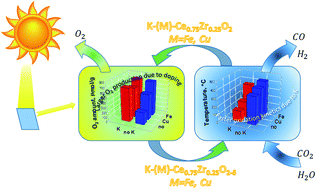Redox behavior of potassium doped and transition metal co-doped Ce0.75Zr0.25O2 for thermochemical H2O/CO2 splitting†
Abstract
CeO2 slow redox kinetics as well as low oxygen exchange ability limit its application as a catalyst in solar thermochemical two-step cycles. In this study, Ce0.75Zr0.25O2 catalysts doped with potassium or transition metals (Cu, Mn, Fe), as well as co-doped materials were synthesized. Samples were investigated by X-ray diffraction (XRD), N2 sorption (BET), as well as by electron paramagnetic resonance (EPR) and X-ray photoelectron spectroscopy (XPS) to gain insight into surface and bulk features, which were connected to redox properties assessed both in a thermogravimetric (TG) balance and in a fixed bed reactor. Obtained results revealed that doping as well as co-doping with non-reducible K cations promoted the increase of both surface and bulk oxygen vacancies. Accordingly, K-doped and Fe-K co-doped materials show the best redox performances evidencing the highest reduction degree, the largest H2 amounts and the fastest kinetics, thus emerging as very interesting materials for solar thermochemical splitting cycles.



 Please wait while we load your content...
Please wait while we load your content...